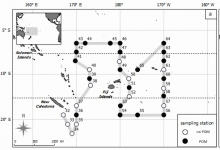Geographic variation in stable isotopic and fatty acid composition of anguilliform leptocephali and particulate organic matter in the South Pacific
Marine Ecology Progress series, VOL 544: 225-241, 2016. doi: 10.3354/meps11575. Camilla Liénart, Eric Feunteun, Michael J. Miller, Jun Aoyama, Jean-Michel Mortillaro, Cédric Hubas, Mari Kuroki, Shun Watanabe, Christine Dupuy, Alexandre Carpentier, Tsuguo Otake, Katsumi Tsukamoto, Tarik Meziane
In the South Pacific, trophic ecology of anguilliform leptocephali was investigated for three families of larvae. Their feeding seems to be based on particulate organic matter (POM) assimilation, however it remains unclear which type of POM they assimilate. The study of C and N stables isotopes (δ13C, δ15N) and fatty acids (FA) composition of both larvae and POM reveals a strong polyunsaturated FA (especially 20:5ω3 and 22:6ω3) contribution to total FA in leptocephali tissues (34 to 42% depending on family) whereas POM only shows a small proportion of those FA (∼9%), which typically indicates a low nutritional quality of this POM. The δ15N signature follows a latitudinal pattern for both the three families of leptocephali and POM with a decrease from north to south, related to oceanic currents. FA composition also shows a similar pattern with POM of the northern current depleted in polyunsaturated FA, similarly to the leptocephali caught in this area. These results suggest the existence of a regional variability in the nutritional quality (saturated FA and 22:6ω3 contributions) and availability of POM (FA markers of different planktonic organisms). Moreover, leptocephali feeding strategies seems to be different depending on the family, with an ability to select the type of POM or to feed opportunistically on every type of POM. Further research about possible differences in assimilation of material from POM or physiological differences among leptocephali families would help to better understand leptocephali feeding ecology.
Ces résultats suggèrent l’existence d’une variabilité régionale dans la qualité nutritionnelle (différentes contributions en AG saturés et 22:6ω3) mais aussi la disponibilité de la MOP (marqueurs AG de différents organismes planctoniques).
De plus, les stratégies alimentaires des leptocéphales semblent différents selon la famille considérée, qui se montre soit capable de sélectionner certains types de MOP, soit de se nourrir de manière opportuniste sur tous les types de MOP. Des recherches futures concernant de possibles différences d’assimilation du matériel issu de la MOP ou encore des différences physiologiques entre les familles de leptocéphales apporteront des connaissances supplémentaires pour comprendre l’écologie trophique des leptocéphales.
BOREA Contact : Tarik Meziane, professor at MNHN, team 6.


